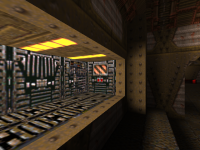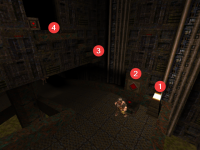Hosting and domain costs until October 2024 have been generously sponsored by dumptruck_ds. Thank you!
Gameplay tips
From Quake Wiki
Contents
Quake is a 3D world, be sure to look up and down as you explore a level. Underwater areas are sometimes the only way to proceed, so go swimming when you have an opportunity.
Weapons and Combat
- Learning the number of shots it takes to down a monster is important for all weapons. This is something you'll get a feel for over time, but is good for saving ammo and knowing when you can switch targets while fighting.
- Damage you deal to yourself with explosive projectiles only does half damage. This can be used to grenade/rocket jump places if you find yourself healthy with good armor. Red armor will absorb almost all of it making it incredibly powerful for doing this.
- Shamblers have 50% damage reduction to explosions, so it's best to avoid using the grenade and rocket launchers against them.
- Zombies can only be gibbed in order to kill them. While the grenade and rocket launchers can always do this, you'll need Quad Damage with every other weapon. Only the nailgun is incapable of killing them outright.
- The axe should largely be avoided as it has extremely low damage and range. Instead, it can be used as a tool for exploration. Some secrets only open when damaging them, so the axe can be used to scout these out potentially and save ammo. It's also very fun to swing.
- The starter shotgun is weak but has good range. Given its relatively tight spread, the fact that it's hitscan, and the abundance of shotgun ammo, it's good for picking off monsters at longer ranges during the early game or for saving less common ammo like nails. Against Knights you can fire a single shotgun shot followed by a super shotgun shot to combo them.
- The super shotgun will be your main work horse weapon throughout the game given the abundance of shotgun ammo and how early you pick it up. Its spread is significantly wider but it also deals over twice as much damage as the starter shotgun. Hitboxes are larger than they might seem so barrel stuffing isn't as necessary on big monsters like Ogres, but try and stick within close range while attacking. Learning how to properly kite melee monsters will help significantly. For hard to reach monsters like the Scrag the nailgun or shotgun is preferred since they'll be much more reliable.
- The nailgun is weak but reliable at medium ranges. Some monsters like the Ogre have low pain thresholds and are easy to keep locked down with it thanks to its fire rate. For beefy enemies like the Death Knight or Fiend, using the super shotgun or a launcher is usually preferred. However, this weapon is good if you find yourself with a lot of nails and low tier enemies to pick off.
- The super nailgun is significantly better than its younger sibling and is one of the most powerful tools in your arsenal. Boasting an insane DPS, this thing can kill anything quickly and reliably out to medium ranges. It uses twice the ammo, however, so your nails will go fast. Try and save this for large monsters like the Shambler or packs of monsters like Ogres and Fiends. You can use the regular nailgun to save ammo against weaker monsters.
- The grenade launcher lacks range but makes it up for it with its fire rate. The grenade hitbox is much smaller than its fellow weapon projectiles, however, so you need to be more precise. Bouncing it off walls and ceilings is a great way to pick off monsters in hard to fight places. Avoid shooting ramps with it as this can sometimes cause your grenade to stop dead in its tracks (specifically if you're trying to shoot down a ramp). The grenade has a brief timer after it stops, so make sure to stay away from it if it hasn't detonated yet. The grenade launcher works amazingly with the Pentagram of Protection as you can barrel stuff monsters with no danger, allowing for incredible DPS.
- The rocket launcher is your best utility weapon. It has good range, great damage, and usually an abundance of ammo, though has a slower fire rate than the grenade launcher. If you find yourself with excess rockets, be sure to use this to help fight against beefier monsters. A bug exists with Shamblers that can sometimes cause projectiles to go through them, so it's best to avoid using this weapon against them on top of their explosive resistance.
- The thunderbolt is your BFG. It boasts the highest DPS in the game albeit with very limited ammo and a short-ish range. Use this for the biggest monsters on the field like the Shambler and Vore. It's also a great back up weapon if you find yourself getting overwhelmed and need to quickly reset the state of the fight. Just make sure not to use it while you're underwater if you don't have a Pentagram.
For tips on dealing with each of the monsters and bosses in Quake, see the Monsters page.
Resource Management
If you find yourself at 95 HP but find a health item, sometimes, the best course of action is to simply ignore the item for now and come back to it when you find yourself more wounded, as even the small heath item will only heal you 5 points instead of the ordinary 15 points if you were more badly injured.
It is also very important to manage your ammo in Quake. As such, some weapons are better left for specific enemies. For example, the Shambler has a 50% damage resistance against explosive weapons such as the Grenade Launcher or the Rocket Launcher, so the next most effective weapon to use would be the Super Nailgun or the Thunderbolt.
Finding Secrets
Quake rewards creative and explorative players with secrets. If you see an odd texture on the wall, chances are you can shoot it to unlock a secret pathway to an item, such as in E1M1: The Slipgate Complex.
Not all secrets are found by blasting buttons, though. For example, another secret in the same level requires you to perform some jumping to get to a secret Mega-Health.
Trick Jumps
Main article: Trick Jumps
Trick Jumps are maneuvers that allow you to achieve a speed, height, or distance beyond what is usually possible with the physics of Quake. In general these 'features' were not intended by the designers at id Software, though there is some evidence that at least some of them were known to the designers during development. They are almost never necessary to progress through a level (with the exception of a few rare user-made levels), but can often be used to take a shortcut to another part of a level.


